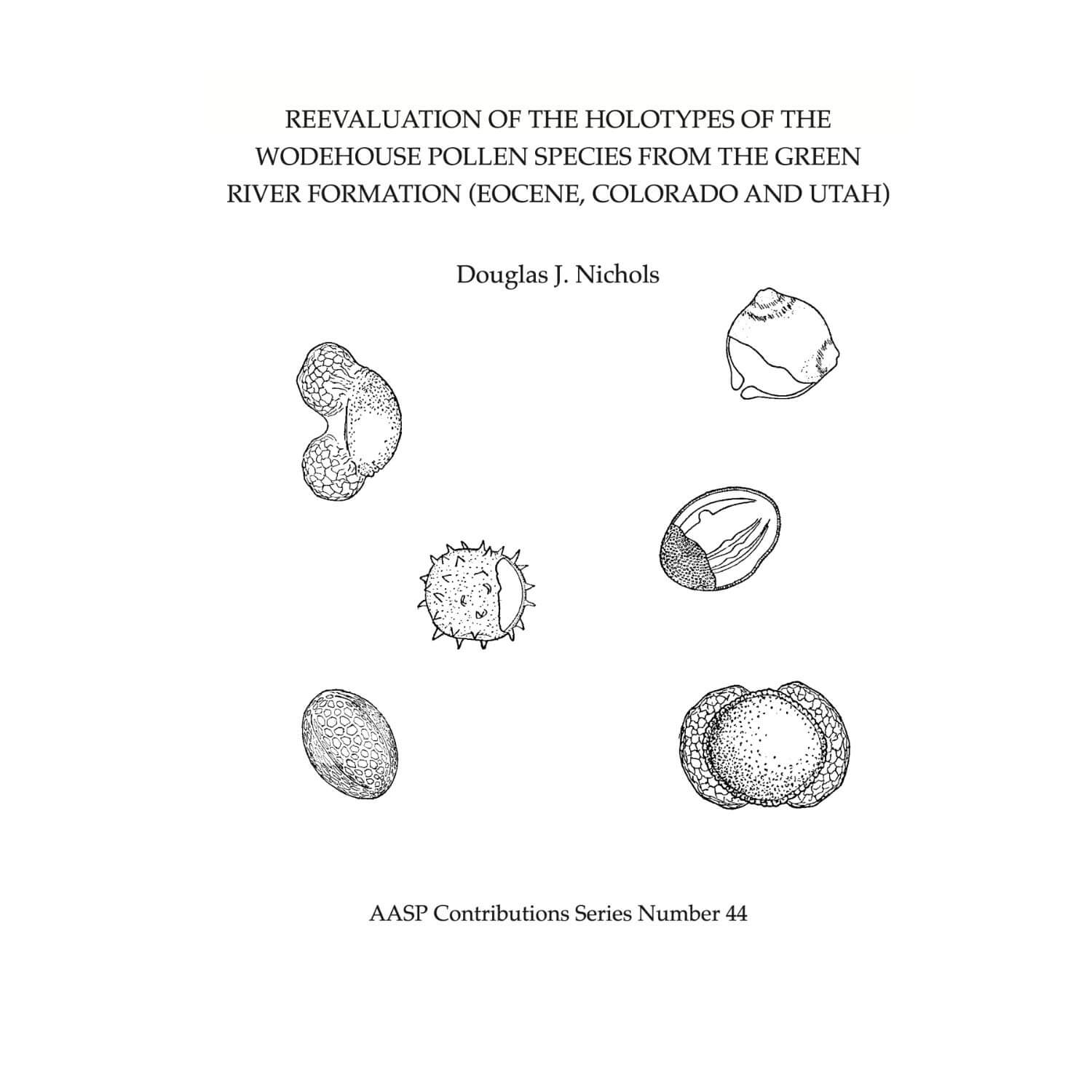Contributions Series Nr. 44
$12.00 – $15.00
Reevaluation of the Holotypes of the Wodehouse Pollen Spcies from the Green River Formation (Eocene, Colorado and Utah)
Douglas J. Nichols
2010
PDF & Hardcopy available
Description
Abstract
In the earliest publication on North American Paleogene palynology, Roger P. Wodehouse (1933, Tertiary pollen–II. The oil shales of the Green River Formation. Bulletin of the Torrey Botanical Club, 60, 479-524) described 15 new genera and 41 new species from the Green River Formation (Eocene, Colorado and Utah). The holotype illustrations were line drawings. The holotype specimens of the Wodehouse pollen species have been located on the original slides and photographed for the first time. Reevaluation of the original material resulted in some major changes in nomenclature and altered the generally accepted concepts of several genera.
The Wodehouse genera are Abietipites, Ailanthipites, Arecipites, Cedripites, Cycadopites, Caprifoliipites, Dioonipites, Ericipites,
Momipites, Myricipites, Peltandripites, Rhoipites, Smilacipites, Talisiipites, and Vitipites. All are accepted as originally described,
with the exception of Abietipites and Smilacipites, which are reinterpreted and emended based on reexamination of the genotypes. Dioonipites was effectively but irregularly published; it is untypified and considered a nomen nudum. The genus
Pseudopotamogetonipites is proposed as new.
Wodehouse’s interpretations and generic assignments for the following species are accepted; the species are redescribed and the holotype specimens photographed: Abies concoloripites, Ailanthipites berryi, Alnus speciipites, Arecipites punctatus, Betula claripites, Caprifoliipites viridifluminis, Cedripites eocenicus, Cycadopites follicularis, Ephedra eocenipites, Ericipites brevisulcatus, Ericipites longisulcatus, Juglans nigripites, Momipites coryloides, Myricipites dubius, Myriophyllum ambiguipites, Peltandripites davisii, Picea grandivesipites, Pinus scopulipites, Pinus strobipites, Pinus tuberculipites, Rhoipites bradleyi,Talisiipites fischeri, and Vitipites dubius. Based on reinterpretations of the holotype specimens, the following new nomenclatural combinations are made: Abietipites (al. Tsuga) viridifluminipites (Wodehouse) comb. nov., Bombacacidites (al. Tilia) crassipites (Wodehouse) comb. nov., Cricotriporites (al. Hicoria) juxtaporipites (Wodehouse) comb. nov., Inaperturopollenites (al. Taxodium) hiatipites (Wodehouse) comb. nov., Intratriporopollenites (al. Tilia) vescipites (Wodehouse) comb. nov., Peltandripites (al. Smilacipites) herbaceoides (Wodehouse) comb. nov., Peltandripites (al. Smilacipites) molloides (Wodehouse) comb. nov., and Pseudopotamogetonipites (al. Potamogeton) hollickipites (Wodehouse) comb. nov.
The following additional nomenclatural changes are made: Abietipites antiquus is emended, Carpinus ancipites is placed in
synonymy with Momipites ancipites (Wodehouse) comb. nov., Engelhardtia corylipites is placed in synonymy with Momipites
coryloides, Liriodendron psilopites is placed in synonymy with Ephedra eocenipites, Smilacipites echinatus is emended, and Tilia
tetraforaminipites is placed in synonymy with Intratriporopollenites vescipites. The following nomenclatural revisions by previous authors are accepted: Carya (al. Hicoria) viridifluminipites (Wodehouse) Wilson & Webster, Inaperturopollenites (al. Cunninghamia) concedipites (Wodehouse) Krutzsch, and Inaperturopollenites (al. Glyptostrobus) vacuipites (Wodehouse) Krutzsch. Based on examination and reinterpretation of the holotype, Arecipites rugosus does not belong in the genus Arecipites and furthermore is unidentifiable. Hence, the name Arecipites rugosus is rejected.
Key words: palynology, Green River Formation, Eocene, Wodehouse, nomenclature, taxonomy, fossil pollen
